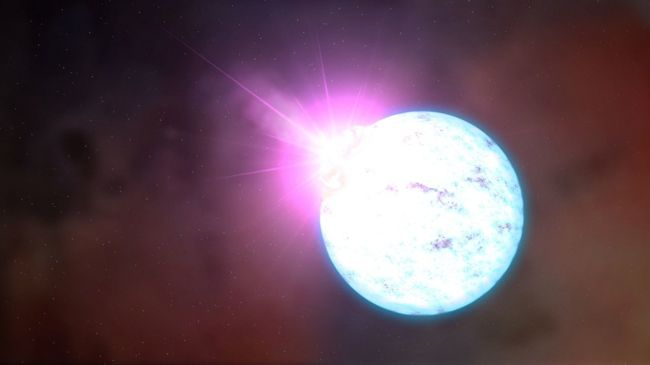By Matt Williams
作者 Matt Williams
September 21, 2018
2018年9月21日
Ever since they were first discovered in the 1930s, scientists have puzzled over the mystery that is neutron stars. These stars, which are the result of a supernova explosion, are the smallest and densest stars in the Universe. While they typically have a radius of about 10 km (6.2 mi) – about 1.437 x 10-5 times that of the Sun – they also average between 1.4 and 2.16 Solar masses.
自从中子星在1930年代被第一次发现,科学家们就对它们的神秘感到困惑。这些超新星爆发产生的恒星,是宇宙中最小最质密的恒星。虽然它们的半径通常约为10公里(6.2英里) - 约为太阳半径的1.437 x 10-5倍 - 但它们的平均质量是太阳的1.4到2.16倍。
At this density, which is the same as that of atomic nuclei, a single teaspoon of neutron star material would weigh about as much as 90 million metric tons (100 million US tons). And now, a team of scientists has conducted a study that indicates that the strongest known material in the Universe – what they refer to as “nuclear pasta” – exists deep inside the crust of neutron stars.
这个密度与原子核的密度相同,一茶匙中子星材料的重量可达9000万公吨(1亿美吨)。如今, 一个科研团队进行研究,表明宇宙中已知最强的物质——他们称为核面食——存在于中子星的地壳深处。
The study, titled “Elasticity of nuclear pasta“, was recently accepted for publication by the Physical Review Letters. The study was led by Matt Caplan, a Postdoctoral Fellow at the McGill Space Institute (MSI), and included members from the California Institute of Technology’s Walter Burke Institute for Theoretical Physics and Indiana University’s Nuclear Theory Center.
该项题为“核面食的弹性”的研究最近被物理评论快报接受发表。该研究由麦吉尔太空研究所(MSI)博士后研究员马特·卡普兰领导,其成员包括加州理工学院沃尔特伯克理论物理研究所和印第安纳大学核理论中心的成员。
Compared to other classes of stars (with the exception of the hypothetical quark stars and strange stars) neutron stars are rather unique. Due to their intense gravity (which causes their outer layers to freeze) neutron stars are similar to Earth in that they have a solid crust surrounding a liquid inner core. Below the crust, the high density causes the formation of material that has a strange structure.
与其他类型的恒星相比(除了假想的夸克星和奇异星)中子星是相当独特的。由于它们强大的引力(导致它们的外层冻结)中子星和地球相似,它们都有固体地壳包裹着液体内核。在地壳之下,高密度导致了奇特结构的物质的形成。
In short, competing forces between the protons and neutrons inside a neutron star causes the material to assemble into strange shapes, such as long cylinders or flat planes commonly referred to as “lasagna” and “spaghetti” – hence the nickname “nuclear pasta”. While a fascinating subject of study, not much has been learned about this material or its mysterious structures.
总之,中子星内部质子和中子的斥力导致物质被组合成了奇特的形状,比如像“烤宽面条”和“意大利面”的柱形或平面——因此绰号叫“核面食”。虽然这是一个引人入胜的研究课题,但对这种物质或它神秘结构的了解并不多。
As Caplan indicated in a recent McGill press release, “The strength of the neutron star crust, especially the bottom of the crust, is relevant to a large number of astrophysics problems, but isn’t well understood.”
正如卡普兰在最近的麦吉尔新闻稿中指出的那样,“中子星地壳的强度,尤其是地壳的底部,涉及大量的天体物理学问题,尚未理清。”
To shed light on this, Caplan and his colleagues successfully ran the largest computer simulations ever conducted of neutron star crusts, and their study was the first to describe how these crusts break. These simulations, which consisted of Caplan and his team stretching and deforming the nuclear pasta to test its strength, required roughly 2 million hours of processor time.
为了阐明这一点,卡普兰和他的同事们成功运行了历史上最大的一次中子星地壳的计算机模拟,他们的研究第一次描绘了这些地壳是如何破碎的。模拟包括了卡普兰和他的团队拉伸核面食并使其变形来测试它的强度,处理器需要运行大约2百万小时。
From this, they determined that their unique shapes, combined with the extreme density inside neutron stars, makes nuclear pasta is incredibly stiff. In fact, its strength even puts materials like graphene and carbon nanotubes to shame. This information could go a long way towards helping astronomers make sense of their observations of neutron stars.
由此,他们决定了它们独一无二的形状,加上中子星内部极端的密度,使得核面食非常坚硬。事实上,它的强度使石墨烯和碳纳米管感到羞愧。这些信息可以帮助天文学家理解观察中子星。
And considering last year’s kilonova event, where two neutron stars collided, these results could also help astrophysicists in the research of gravitational waves. The study even suggests that neutron stars might generate small amounts of gravitational waves on their own. As Caplan indicated, knowing more about how materials behaves inside a neutron star, scientists may be able to shed new light on the unusual physics that take place within them:
考虑到去年两个中子星相撞的千回转事件,这些结果也可以帮助天体物理学家研究引力波。研究甚至表明中子星可以自己产生少量的引力波。正如卡普兰所指出的,了解越多中子星内部物质的行为,科学家们就越可能阐明其中发生的不寻常的物理学:
“A lot of interesting physics is going on here under extreme conditions and so understanding the physical properties of a neutron star is a way for scientists to test their theories and models. With this result, many problems need to be revisited. How large a mountain can you build on a neutron star before the crust breaks and it collapses? What will it look like? And most importantly, how can astronomers observe it?”
许多有意思的物理现象都发生在极端条件下,因此理解中子星的物理特性是物理学家测试他们的理论和模型的一种方法。有了这个结果,许多问题都要重新审视。地壳不破裂的条件下中子星上可以建造多大的山体?地壳破裂时会如何?最重要的是,天文学家如何观察它?
The ability to study and model the interior’s of neutron stars, supernovae – not to mention the ability to detect gravitational waves – are all part of how astronomy is advancing by leaps and bounds.
研究和模拟中子星,超新星内部- 更不用说探测引力波 - 都是天文学突飞猛进的一部分。
Source: Universe Today - Further Reading: McGill, Physical Review Letters
资料来源:今日宇宙 - 进一步阅读:麦吉尔,物理评论快报


